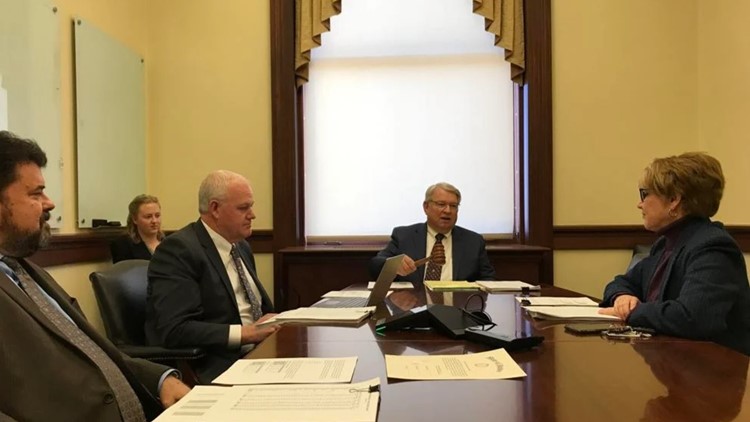BOISE, Idaho — This article originally appeared in the Idaho Press.
Turnout in Idaho’s Nov. 8 general election was considerably lower than expected – just 56.8% of registered voters statewide, according to the final election results certified this week by the state Board of Canvassers.
“It’s very low – I was expecting 70%,” said Idaho Secretary of State Lawerence Denney. “And the highest county was only 69%.”
“I guess turnout is driven by people and issues, and nobody was excited,” Denney said.
According to the final, certified results, the highest voter turnout in the state came in Camas County, at 69%; followed by Boundary County, up by the Canadian border, at 67.4%; Adams County, 67.1%; and Idaho County in north-central Idaho, 66.3%.
The lowest turnout in the state was in Madison County, an outlier with just 38.6% of registered voters casting ballots. Second-lowest was Nez Perce County, 41.2%; and third-lowest was Canyon County, at 50.8% – the second-largest county in the state by population.
Ada County had 58.5% turnout among registered voters.
Denney chairs the state Board of Canvassers; its other two members are state Controller Brandon Woolf and state Treasurer Julie Ellsworth. When the board met to certify the results on Wednesday, Ellsworth asked, “What’s going on with Madison? Why is there such a low turnout there?”
Deputy Idaho Secretary of State Jason Hancock said that’s likely because Madison County, home of BYU-Idaho in Rexburg, has a large number of students who registered to vote in the presidential election in 2020, but might not have voted again since, and thus haven’t been purged from the county’s voter rolls.
Two other counties with large numbers of college students had differing turnouts, however. Nez Perce County, home of Lewis-Clark State College, had the second-lowest turnout. But Latah County, home of the University of Idaho, had 62.6% turnout among registered voters; just 10 of Idaho’s 44 counties had higher voter turnout.
Woolf noted that Latah County had hotly contested legislative races, which could account for increased interest and turnout there.
In the 2020 general election, 81.16% of Idaho’s registered voters turned out. That equaled 65.62% of the state’s total voting-age population at the time.
In 2018, the last comparable mid-term election, 66.75% of Idaho’s registered voters cast a ballot, or 48.11% of the state’s voting-age population.
From 1982 to 2018, Idaho’s mid-term election turnout averaged 62.1% of registered voters, or 46.3% of the state’s voting-age population.
Denney noted that the final, certified election results continued to show an increasing preference among Idahoans for early or absentee voting. Statewide, 31.9% of Idaho’s voters chose those options over voting in person at the polls on election day.
“Almost a third of the votes are already in before election day,” Denney said.
That figure varied by county. The highest proportion of early and absentee voting was in Nez Perce County, where 51.5% of voters chose those options. The lowest was Franklin County, at just 9.2%.
Woolf, who hails from Preston in Franklin County, said, “They don’t do early voting. It’s just the tradition to go on election day.”
Ada County saw 36.9% of voters in November choose absentee or early voting. Canyon County was at 38.5%.
The board also discussed Idaho’s second-ever set of post-election audits, which examined results in eight randomly selected counties prior to the final certification. Crews flew all over the state to conduct hand-counts of precincts in the selected counties; all came in near-perfect. In fact, all matched 100%, except for tiny Oneida County, which was off by a single vote.
However, that discrepancy was accounted for by the difference between the machine-reading and hand-counting of the paper ballots, because a person could see a light mark that a machine might not pick up and would count as an undervote, or a ballot with nothing marked on that line. The total number of ballots was identical.
“I’m surprised that you can count 2,000 ballots and come out with the same number every time,” Denney commented.
State election official Sheryl Millard, who was on the audit crew, said, “The clerks are amazing.”
Denney said there were a handful of races in which the outcome was close enough that the losing party could request a recount, but none were so close that they fell into the free-recount margin.
“Overall, I’m happy with the results,” said Denney, who is retiring after this year; this was the final general election he’ll oversee. “I don’t think we’ve ever had a perfect election yet, but that’s what we strive for.”
He noted that the tight time frame for conducting the audits before the canvass “has really stressed our timeline,” with crews of auditors finally arriving back in Boise just before midnight the night before the Board of Canvassers meeting.
Said Ellsworth, “It’s a good thing, though.”
Betsy Z. Russell is the Boise bureau chief and state capitol reporter for the Idaho Press and Adams Publishing Group. Follow her on Twitter at @BetsyZRussell.
This article originally appeared in the Idaho Press, read more on IdahoPress.com.
Watch more Local News:
See the latest news from around the Treasure Valley and the Gem State in our YouTube playlist:



